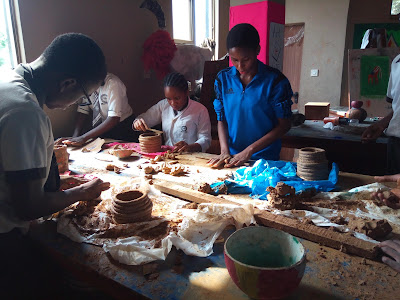Tuesday, 30 May 2017
Tuesday, 23 May 2017
MY LEARNERS WORKING ON MURAL DESIGN
The image depicts some of my learners creating pattern on a surface to form a mural design.
However, the word Mural originates from the Latin word “murus”, meaning “Wall" . A mural is any piece of artwork painted or applied directly on a wall, ceiling or other permanent surface. A distinguishing characteristic of mural painting is that the architectural elements of the given space are harmoniously incorporated into the picture.
Some wall paintings are painted on large canvases, which are then attached to the wall (e.g., with marouflage). Whether these works can be accurately called "murals" is a subject of some controversy in the art world, but the technique has been in common use since the late 19th century.
YOUNG POTTERS
Coiling is a method of creating pottery. It has been used to shape clay into vessels for many thousands of years. It ranges from Africa to Greece and from China to New Mexico. They have used this method in a variety of ways. Using the coiling technique, it is possible to build thicker or taller walled vessels, which may not have been possible using earlier methods. The technique permits control of the walls as they are built up and allows building on top of the walls to make the vessel look bigger and bulge outward or narrow inward with less danger of collapsing. There are many ways to build ceramic objects using the coiling technique. To do this, the potter takes a pliable material (usually clay) then rolls it until it forms a long roll. Then, by placing one coil on top of another, different shapes can be formed.
One of the methods used in terra-cotta sculpture; the clay is rolled into cylindrical strips about the size of an ordinary pencil and wound up to create the desired shape.
Subscribe to:
Comments (Atom)






